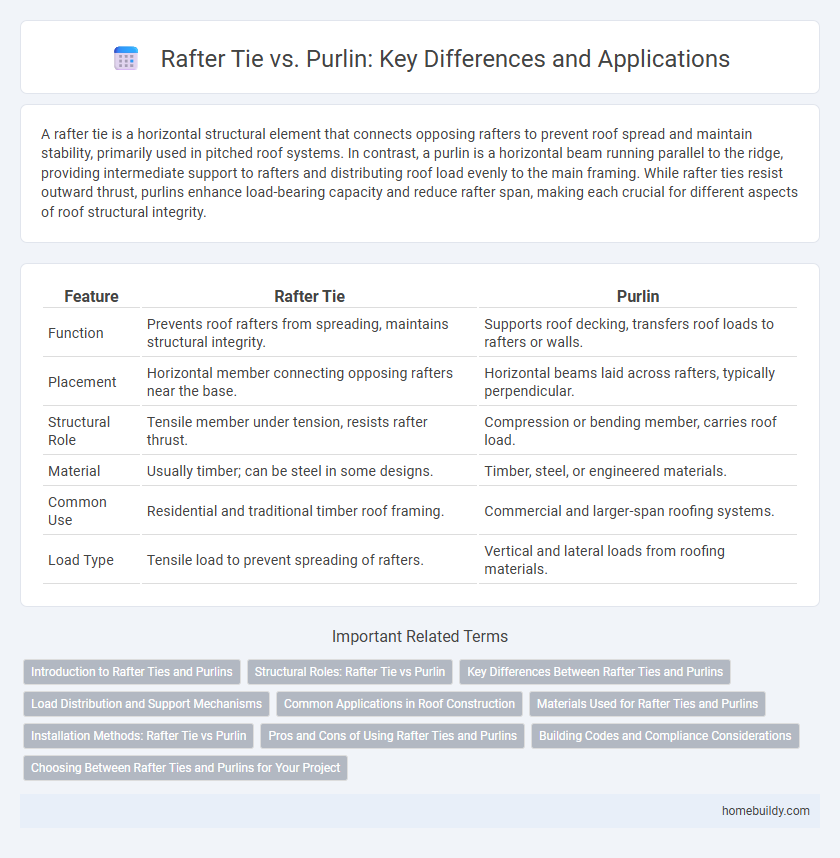A rafter tie is a horizontal structural element that connects opposing rafters to prevent roof spread and maintain stability, primarily used in pitched roof systems. In contrast, a purlin is a horizontal beam running parallel to the ridge, providing intermediate support to rafters and distributing roof load evenly to the main framing. While rafter ties resist outward thrust, purlins enhance load-bearing capacity and reduce rafter span, making each crucial for different aspects of roof structural integrity.
Table of Comparison
| Feature | Rafter Tie | Purlin |
|---|---|---|
| Function | Prevents roof rafters from spreading, maintains structural integrity. | Supports roof decking, transfers roof loads to rafters or walls. |
| Placement | Horizontal member connecting opposing rafters near the base. | Horizontal beams laid across rafters, typically perpendicular. |
| Structural Role | Tensile member under tension, resists rafter thrust. | Compression or bending member, carries roof load. |
| Material | Usually timber; can be steel in some designs. | Timber, steel, or engineered materials. |
| Common Use | Residential and traditional timber roof framing. | Commercial and larger-span roofing systems. |
| Load Type | Tensile load to prevent spreading of rafters. | Vertical and lateral loads from roofing materials. |
Introduction to Rafter Ties and Purlins
Rafter ties are horizontal structural members installed between opposing rafters to prevent roof spread by resisting outward thrust. Purlins run parallel to the ridge, spanning across rafters to provide mid-span support, increasing the roof's load-bearing capacity. Both components are essential in roof framing but serve distinct roles in maintaining structural stability and distributing loads.
Structural Roles: Rafter Tie vs Purlin
Rafter ties function as horizontal connectors that prevent roof rafters from spreading apart, ensuring structural stability by resisting outward thrust forces in the roof framework. Purlins act as horizontal beams spanning across rafters, providing mid-span support to reduce bending and deflection in the roof decking. While rafter ties primarily enhance the roof's lateral load resistance, purlins contribute to vertical load distribution and overall roof stiffness.
Key Differences Between Rafter Ties and Purlins
Rafter ties connect opposing rafters to prevent outward wall thrust and increase roof stability, primarily resisting lateral forces. Purlins run parallel to the ridge beam, supporting rafters by distributing roof loads and preventing sagging across spans. While rafter ties enhance structural integrity by counteracting tension, purlins mainly provide intermediate support and load distribution along the roof framework.
Load Distribution and Support Mechanisms
Rafter ties primarily function to prevent roof rafters from spreading outward by providing tension connections between opposing rafters, enhancing structural stability under lateral loads. Purlins serve as horizontal support beams laid perpendicular to rafters, distributing roof loads across the rafters and transferring weight to the building's main frame or walls. Load distribution in rafter ties involves tensile forces that resist rafter separation, while purlins primarily handle bending forces to support roof decking and reduce rafter spans.
Common Applications in Roof Construction
Rafter ties are commonly used in roof construction to prevent the outward spread of rafters and provide structural stability for pitched roofs. Purlins serve as horizontal supports laid across rafters or trusses, primarily to carry roof decking or sheathing materials. While rafter ties reinforce the roof's internal frame, purlins are essential in supporting and distributing loads across the roof surface.
Materials Used for Rafter Ties and Purlins
Rafter ties are commonly made from dimensional lumber such as 2x4 or 2x6 pine, known for their strength and ease of installation, providing lateral support to rafters. Purlins typically use steel or engineered wood products like LVL (Laminated Veneer Lumber) for enhanced load-bearing capacity and longer spans in roofing systems. The choice of materials directly impacts the structural integrity and longevity of the roof framework in both rafter ties and purlins.
Installation Methods: Rafter Tie vs Purlin
Rafter ties are installed by fastening horizontal members between opposite rafters to prevent outward spread of walls, typically using nails or screws at the rafter's midpoint. Purlins, in contrast, are horizontal beams laid perpendicular to rafters, secured via metal brackets or hangers to support roofing materials. The rafter tie method focuses on structural reinforcement within the roof frame, whereas purlin installation emphasizes load distribution across the roof surface.
Pros and Cons of Using Rafter Ties and Purlins
Rafter ties provide strong lateral support by preventing rafters from spreading and are typically easier to install in standard roof framing, but they can limit attic space and ventilation. Purlins, running horizontally across rafters, offer additional mid-span support and allow for larger roof spans and more open attic areas but require more complex installation and additional structural components. Choosing between rafter ties and purlins depends on roof design, load requirements, and desired attic functionality.
Building Codes and Compliance Considerations
Rafter ties are critical components in roof framing, designed to prevent outward thrust on walls and comply with International Residential Code (IRC) requirements for structural integrity. Purlins serve to support rafters horizontally but must meet specific load and span criteria outlined in building codes like the IBC for safe roof construction. Compliance considerations emphasize using rafter ties in residential roofs per IRC guidelines, while purlins are governed by engineering specifications to ensure stability and code adherence in various building types.
Choosing Between Rafter Ties and Purlins for Your Project
Rafter ties provide critical tension support by preventing roof rafters from spreading and ensuring structural stability, making them essential in pitched roof designs where ceiling joists are absent. Purlins function as horizontal beams that support the roof deck and transfer loads to rafters, ideal for large-span roofs requiring additional intermediate support. When choosing between rafter ties and purlins, consider the roof type, load requirements, and whether lateral rafter restraint or additional deck support is the primary structural need.
Rafter tie vs Purlin Infographic

 homebuildy.com
homebuildy.com